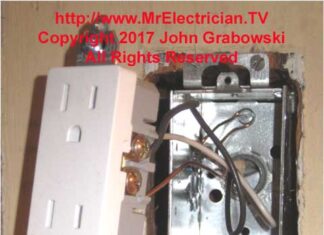Tag: madison bars
Install Outlet in an Existing Wall
Dear Mr. Electrician: I want to install an outlet in an existing wall on a dedicated circuit for my window air conditioner. I've figured out how to run the 12/2 NM-B cable from the basement's main circuit breaker electrical panel up through the wall under the living room window. How do I install an electrical receptacle box in the wall containing the wires and supporting the receptacle?
Answer: To install an outlet in an existing wall requires a lot of measuring. Assuming that you will be drilling a hole from below and fishing the cable into the outside wall, the best place to cut a hole and mount a box is adjacent to a wall stud. The electrical box can be screwed through its side directly to the wood to make it solid.
Table of Contents:
Locating A Wall Stud
How To Install A Plastic Old Work Electrical Box
How To Use Madison Bars
How To Install An Outlet Box In Wood Lathe and Plaster
Tools and Materials For Outlet Box Installation
NOTE: Some text links below go to applicable products on Amazon or eBay. As an Amazon Associate, I earn from qualifying purchases. Using my links helps to keep this website FREE.
LOCATE WALL STUD TO INSTALL OUTLET BOX
Locating a wall stud may not be that easy. I usually use an existing wall receptacle or switch as a reference. They are most likely mounted on wall studs if installed when the house was built.
I would remove the wall plate from the existing receptacle or switch and poke a long, thin screwdriver into the electrical box's right and left. I would also push the box a little to see if it pivots. Usually, the side that is mounted to the stud will not move.
To install an outlet in an existing wall in newer homes with drywall, I also look for indications of nail holes that were spackled over to locate wall studs. I use a flashlight by shining it parallelly close to the wall surface. This shows up all of the blemishes, dimples, nail pops, and patches.
A magnet is also helpful in finding the nails and screws in the wall studs.
After I spotted a few studs, I measured over to the area where I would like to cut a hole for a receptacle. In most home construction, the wall studs are sixteen inches apart, but that is not always the case.
Top Of Page
Sometimes, wall studs are twenty-four inches apart. On some taller condominium buildings, I have found the outside walls to have studs twelve inches apart. Measurement is from center to center, and I always measure twice. If I am lucky, my measurement will correspond with a spackled nail hole, which confirms that I have a stud. Tool and material list below.
One trick I learned from my dad is to measure 48" from the inside corner of any wall. There should always be a wall stud because drywall and paneling are 48" wide and need a stud to land their edge on...
